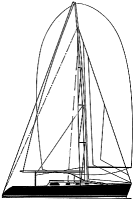Lidgard 13.7-meter
Performance cruiserr
The patriarch of this group is John Lidgard, who started his designing and building career at the age of 17. John named his first boat after his girlfriend Heather. Today, 50 years later, John still has both Heathers. His building business is now run by his son Duthie and they share a loose association in design efforts. Cousin Jim runs the Halsey Lidgard sailmaking group.
This design was a joint effort of Duthie and John and is a boat aimed at high-performance cruising and occasional racing. There is a racing version with taller rig and longer cockpit, but I'll confine my comments to the cruising version.
If you look back 20 years at the origins of the New Zealand type, you'll find light, narrow boats with fractional rigs and fine entries. Things have not changed much. This new Lidgard design has a fine entry but no hollows. The sectional shape forward shows deadrise; it is distinctly V-ed. This deadrise eventually fairs to a soft, flat sectional shape around station 6. The topsides are gently flared. Overhangs are minimal. Prismatic coefficient is .537, and thatÕs textbook normal. The D/L is 96. Anything under 100 is light for a cruising boat. I have a full set of lines for this hull and it is clear that this is a very fast hull shape.
Keel and rudder look like they could belong on any race boat. The keel fin has plenty of chord with a long, circular section bulb at the tip. Bulbs by themselves are not fast. As the local Halsey Lidgard sailmaker Doug Christie says, "If bulbs were fast we'd put them on the top of sails." Bulbs can make a boat fast by lowering the VCG. Note that the planform of the rudder is almost exactly equal to 50 percent of the keel planform.
The cruising version has a tall fractional rig. There is no overlapping of the mainsail roach on the backstay. I have this feature now on my own boat with my new mainsail and I'm still working with it, but the prognosis at this time is that while the shape is delicious, the oversize roach is more of a bother than a benefit. The SA/D is 22. John would have preferred the taller rig, but he reduced the rig size at his client's wishes. Designers have to do that. The argument between fractional and masthead rigs is, once again, usually a matter of sailing style. I like the simplicity and strength of the masthead rig but I like the versatility of the fractional rig. My own boat has a fractional rig. Fractional rigs are pretty.
This boat uses timber construction-all first-grade Kauri pine, New Zealand's classic boatbuilding material. The major structural elements, including stem, backbone, frames and floors, are laminated Kauri. The deck and coachroof are a combination of GRP and plywood with end-grain balsa being used for the cabintop. The hull skins are 23-ounce triaxial laminates over 1-inch Duracore with an extra outside layer of glass below the waterline. This is a true composite yacht.
The interior is ideal in my book. There is one generously sized head forward. Note the pilot berths in the saloon. They ensure that this boat was designed for passagemaking. There is a shower stall aft.

Comments